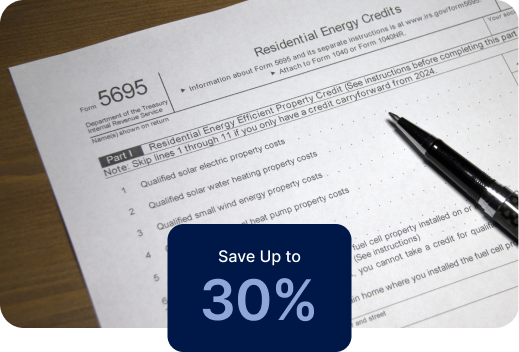The renewable energy sector continues to expand, despite policy uncertainty under the Trump administration.
North Carolina Solar Incentives: 2025 Overview
North Carolina offers great incentives to make solar energy affordable. Homeowners can utilize the 30% Residential Clean Energy Credit, and the state provides net metering, allowing residents to earn credits for extra energy to reduce future bills. With additional utility rebates and financing options available, going solar in North Carolina is a smart choice to…

Residential Clean Energy Credit
The Clean Electricity Investment Credit (previously called the Federal Investment Tax Credit) helps lower the cost of installing solar panels by 30%. This credit covers everything: the solar panels, equipment, labor, permits, and even sales tax.
For example, as of 2025 the average cost of a 10 kW solar system in the U.S. typically ranges between $21,000 and $29,500 before applying any federal tax incentives. After claiming the 30% Clean Electricity Investment Credit, the price drops to around $14,980 to $21,070, depending on the state and other factors like equipment quality and labor costs.
To claim this credit, you must buy your solar system with cash or a loan (leases don’t qualify). You also need to owe enough in taxes to claim the credit, but if you don’t, you can carry it over to future years until 2034.

Claiming the Clean Electricity Investment Credit is simple!
Step 1
Print IRS Form 3468
Step 2
Fill out the form using info from your installer
Step 3
Submit it when you file your taxes
What are the top solar incentives in North Carolina?
Besides the Clean Electricity Investment Credit (former ITC), homeowners can take advantage of several outstanding incentives that significantly enhance the return on investment for solar panels. Here are some of the most effective ways to lower your solar installation costs.
Incentive
Savings
Summary
Renewable Energy Tax Credit – Personal
North Carolina offers a tax credit equal to 35% of the cost of eligible renewable energy property constructed, purchased or leased by a taxpayer and placed into service in North Carolina during the taxable year. The credit has been amended several times since its original inception. House Bill 512 of 2009 extended the eligibility to geothermal equipment, extended the expiration date to December 31, 2015, and allowed the credit to be taken against the Gross Premiums Tax. HB 1829 of 2010 further extended this credit to combined heat and power systems. The credit is subject to various ceilings depending on sector and the type of renewable-energy system. The credit can be taken against franchise tax, corporate tax, income tax, or in the case of insurance companies, against the gross premiums tax.
Residential Renewable Energy Tax Credit
A taxpayer may claim a credit of 30% of qualified expenditures, after deducting incentives, with no upper limit for a system that serves a dwelling unit located in the United States that is owned and used as a residence by the taxpayer. Expenditures with respect to the equipment are treated as made when the installation is completed. If the installation is at a new home, the “placed in service” date is the date of occupancy by the homeowner. Expenditures include labor costs for on-site preparation, assembly or original system installation, and for piping or wiring to interconnect a system to the home. If the federal tax credit exceeds tax liability, the excess amount may be carried forward to the succeeding taxable year. The excess credit may be carried forward until 2019, but it is unclear whether the unused tax credit can be carried forward after then.
Solar Rebate
Residential customers: $6,000 rebate maximum. Customers can get 60 cents per watt of solar energy installed. A larger system may be installed, but this incentive is limited to up to 10 kW.
Solar Rebate
Residential customers: $6,000 rebate maximum. Customers can get 60 cents per watt of solar energy installed. A larger system may be installed, but this incentive is limited to up to 10 kW.
Residential Renewable Energy Tax Credit
A taxpayer may claim a credit of 26% of qualified expenditures, after deducting incentives, with no upper limit for a system that serves a dwelling unit located in the United States that is owned and used as a residence by the taxpayer. Expenditures with respect to the equipment are treated as made when the installation is completed. If the installation is at a new home, the “placed in service” date is the date of occupancy by the homeowner. Expenditures include labor costs for on-site preparation, assembly or original system installation, and for piping or wiring to interconnect a system to the home. If the federal tax credit exceeds tax liability, the excess amount may be carried forward to the succeeding taxable year. The excess credit may be carried forward until 2019, but it is unclear whether the unused tax credit can be carried forward after then.
Residential Renewable Energy Tax Credit
A taxpayer may claim a credit of 22% of qualified expenditures, after deducting incentives, with no upper limit for a system that serves a dwelling unit located in the United States that is owned and used as a residence by the taxpayer. Expenditures with respect to the equipment are treated as made when the installation is completed. If the installation is at a new home, the “placed in service” date is the date of occupancy by the homeowner. Expenditures include labor costs for on-site preparation, assembly or original system installation, and for piping or wiring to interconnect a system to the home. If the federal tax credit exceeds tax liability, the excess amount may be carried forward to the succeeding taxable year. The excess credit may be carried forward until 2019, but it is unclear whether the unused tax credit can be carried forward after then.
Solar Rebate
Residential customers: $4,000 rebate maximum. Customers can get 40 cents per watt of solar energy installed. A larger system may be installed, but this incentive is limited to up to 10 kW.
Residential Renewable Energy Tax Credit
A taxpayer may claim a credit of 30% for the installation which was between 2022-2032 (Systems installed on or before December 31, 2019 were also eligible for a 30% tax credit), with no upper limit for a system that serves a dwelling unit located in the United States that is owned and used as a residence by the taxpayer. Expenditures with respect to the equipment are treated as made when the installation is completed. If the installation is at a new home, the placed in service date is the date of occupancy by the homeowner. Expenditures include labor costs for on-site preparation, assembly or original system installation, and for piping or wiring to interconnect a system to the home.
Sunsense Solar PV Program
Duke Energy Progress is offering incentives for their residential customers to install photovoltaics (PV) systems on their homes through their SunSense Program. The incentive is multifaceted. Customers will receive an upfront payment of $250 for every kilowatt-AC (kW-AC) they install on their home, and they will receive monthly credits on their bill of $4.50 per kW-AC. For instance, if a customer installs a 10 kW-AC system, the largest system eligible to participate in the program, the customer will receive a check for $2,500 plus a bill credit of $45 on their monthly bills. To participate in the program, the customer must surrender all their Renewable Energy Credits (RECs) to Duke Energy Progress for a period of five years and they will receive the $4.50 per kW bill credits throughout those five years. After those first five years, there may be an opportunity for the customer to renew their REC contract with Progress Energy under the terms of the agreement that exists at that time.
Solar Rebate
Residential customers: $6,000 rebate maximum. Customers can get 60 cents per watt of solar energy installed. A larger system may be installed, but this incentive is limited to up to 10 kW.
Solar Rebate
Residential customers: $6,000 rebate maximum. Customers can get 60 cents per watt of solar energy installed. A larger system may be installed, but this incentive is limited to up to 10 kW.
Solar Rebate
Residential customers: $6,000 rebate maximum. Customers can get 60 cents per watt of solar energy installed. A larger system may be installed, but this incentive is limited to up to 10 kW.
Disclaimer: The information provided here regarding solar incentives, tax credits, and rebates is for general informational purposes only and may vary based on your specific circumstances. For exact details, eligibility requirements, and current rates, we recommend consulting a certified solar installer or a tax professional. Incentives can differ by location, utility provider, and individual project, so it’s important to get personalized advice for your solar installation. Always verify the most up-to-date information from your local solar installer to understand how these incentives apply to your project.
Knowledge Base
Find everything you need to know about solar in your state and nationwide

Get a Quote
Discover the Ideal Solar System for Your Home in Just a Few Clicks!







